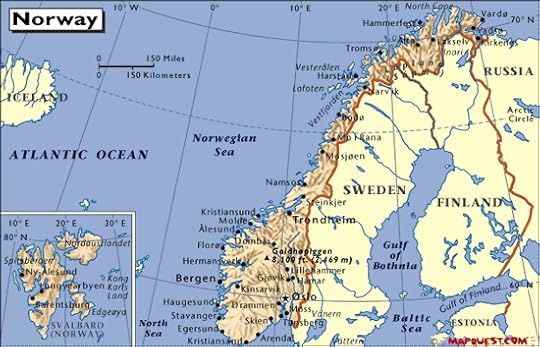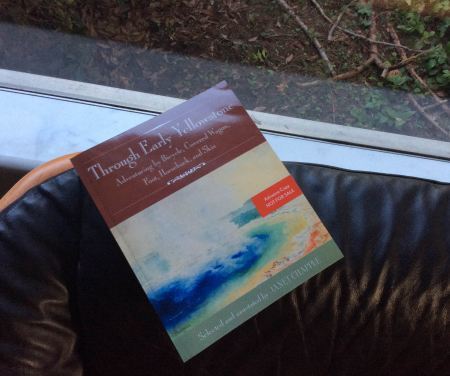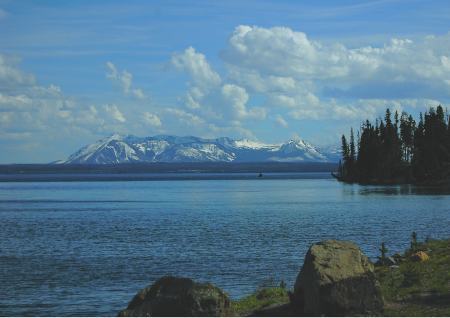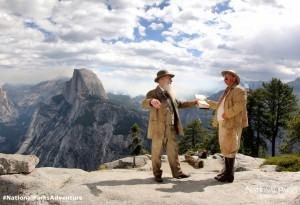Janet Chapple's Blog, page 11
April 22, 2016
Yellowstone News Unseen and Seen
Exciting for Granite Peak Publications and me is to know that our shipment of several pallets of spanking new copies of Through Early Yellowstone arrives today at the Port of Seattle from China! That’s the unseen news.
The fun-to-see news appeared this morning in the Yellowstone Foundation newsletter. It’s the announcement of the winners in their Yellowstone Forever Photo Contest.View a slide show of the 100 top entries.Their 2016 contest will open in June.
April 20, 2016
E-books for international readers

In early April 2016 we got this message on the Granite Peak contact form:
Please make Yellowstone Treasures available for international customers through iBooks/iTunes. I love the book, but books are heavy so I would like to have it with me as an ebook when I travel to the US and Yellowstone later this year. When trying to buy it in the iTunes store I am told I need an American account to buy it. Other ways I can get the pdf or epub?
Best Regards
Ann Kristin Lindaas from Norway
I’d like to share our correspondence, edited for length, so everyone knows people around the world can now easily get the Yellowstone Treasures ebook.
April 9
Dear Ann Kristin,
I’m sorry you are having trouble obtaining Yellowstone Treasures as an ebook from outside North America. The problem is that I had only officially granted US and Canadian rights to my distributor. I will add you to the e-newsletter list and try to notify you as soon as the pdf and other versions are available to the rest of the world. The distributor says they are changing this!
Enjoy your trip!
Regards,
Beth
Editor and Publisher
Granite Peak Publications
April 10
That’s great news! I have already bought the print book and I really enjoy it. Essential for planning my days in Yellowstone! I will be traveling the US for about a month in September and I’m hoping to bring electronic versions of most of the books I’ve bought 
April 11, 2016
Yellowstone Bison Get Room to Roam at Last

Bison herd in winter
The Livingston Enterprise recently reported a rare coming-together of often contentious parties. Federal, state, and tribal agencies that manage Yellowstone Park bison have agreed to let bison stay in parts of Montana year-round. The members of the Interagency Bison Management Plan have verbally agreed to Montana Governor Steve Bullock’s decision to allow the big animals to roam outside the park in search of food on an estimated 400 square miles north and west of the park.
Searching through my past blog posts for what I’ve written before about bison, I can only find rare mentions of the biggest and perhaps most charismatic of Yellowstone’s “charismatic megafauna.” And even in the thirty-five or more “Nuggets” of park information I’ve supplied, somehow I’ve managed to skip writing about bison. These days, when you go to the park, you may not see bears or wolves, and even elk are not so common as they were when I started writing about the park. But bison?—oh, yes, you’ll see herds of them!
Wild animals are not even mentioned in the 1872 act of Congress that set aside “a certain Tract of Land lying near the Head-waters of the Yellowstone River” in “the Territories of Montana and Wyoming.” Regulations were to be set up for the preservation of “timber, mineral deposits, natural curiosities, or wonders,” and “wanton destruction of the fish and game” was frowned upon. That animals were not mentioned in the Organic Act does not surprise me, since in the 1870s there were still millions of bison in the U.S. West, and other wild animals were everywhere, too. What need was there to preserve them?
The fate of the bison illustrates probably the most grievous case of man’s wanton destruction of a natural resource in America’s history. Not only did hunters nearly eradicate the bison during the last decades of the 19th century, but the slaughter was actually encouraged by the government to suppress the Native American Indians who depended upon them.
During the 20th century, different efforts to bring bison back to Yellowstone met with varying success, but now there are close to 5,000 of them in and near the park. This is really too many to be manageable in the parts of the park where they prefer to graze. In recent decades the question of whether they can transmit brucellosis to domestic cattle has greatly complicated the scene and caused major strife between the National Park Service and other interested agencies. Brucellosis is a disease that can cause a pregnant cow to abort her calf, understandably a concern for Montana ranchers. But no cases of the disease being transmitted from bison to cattle have ever been documented, and besides, elk can also carry brucellosis.
Since 2000, wandering bison have sometimes been hazed back into the park in wintertime. Some have been quarantined and others relocated to Indian reservations. With this spring’s new regulation, the iconic animal that appeared on the “buffalo nickel” for decades has a better chance to survive severe winters.
I must issue a word of warning, though: more people are injured in Yellowstone by bison than by any other animal. Lately visitors are being injured and even killed while taking so-called selfies. Bison look placid but are NOT tame and can run very fast. Stay at least 25 yards away—unless, while driving, you are caught in a “bison jam.” This happens especially in Hayden Valley, where the animals frequently cross the highway. In that case, stay in your car and wait patiently!
April 2, 2016
Great bike-riding opportunity this month!
Some of the plowed roads in Yellowstone are open for just a short time every year to bike riders. This great opportunity to enjoy the road from West Yellowstone to Mammoth car-free lasts until April 15th, when the other park roads gradually open to motorized vehicles. You can enjoy the quiet, the animals, and all the beauties of the northwest part of the park on two skinny wheels. Click here for all the details. Note that the road from Madison to Old Faithful is closed at this time for bear management.
The same privilege is offered by Glacier National Park in northern Montana—another paradise. But Going-to-the-Sun Highway requires really ambitious bike riders with good brakes!
March 24, 2016
Plans for the Yellowstone grizzly

Grizzly bear on Swan Lake Flats, Yellowstone
Grizzly bears have been in the news in recent years. First, because human-bear conflicts have been more numerous, including a total of six deaths of people since 2010. Managing these conflicts and the bear predation on cattle means about twenty grizzlies are intentionally killed or removed to zoos per year (see this database if you are interested). In 2016 the news is that the U.S. Fish and Wildlife Service is proposing to take them off the Endangered Species list by the end of the year. The National Park Service put together an informative page about the history of efforts to help the Yellowstone-area grizzly recover, including listing it and delisting it, plus explaining how to minimize encounters with bears and ensure your safety if you do accidentally come close to one. You can find the article here: “Grizzly Bears and the Endangered Species Act.” The most recent delisting was in 2007, but a court ruling overturned that and put them back on the threatened species list in 2009.
Here’s a quick list of safety points, courtesy of the NPS. When backcountry hiking, you can reduce the odds of being injured by a bear by following these five rules:
Hike in groups of three or more people.
Stay alert.
Make noise in areas with poor visibility.
Carry bear spray.
Don’t run during encounters with bears.
The grizzly bear population has made a remarkable recovery, to about 700 individuals in the Greater Yellowstone Ecosystem. So why is delisting controversial? Some are worried about plans for hunting in the surrounding states of Idaho, Montana, and Wyoming. For a March 20, 2016, article that quotes the state governors on the subject, see “US seeks end to Yellowstone grizzly protections” on the Explore Big Sky website.
Do you have an opinion on this subject? Isn’t this photo beautiful? Write your informed comment below.
—Editor Beth
Photo by Jim Peaco for the National Park Service, June 2005.
March 8, 2016
Get a free copy of “Yellowstone Treasures”!
Here’s your chance to get a free signed copy of my popular guidebook!
As a Goodreads author, my “Yellowstone Treasures” is eligible for their Giveaway program, which goes on from now through April 7th. Just go to:
this Goodreads link
and take a chance on receiving a free book. It will help you plan for your next trip to Yellowstone Park and enjoy the park to the utmost while you’re there.
March 1, 2016
Happy birthday, Yellowstone!
Posted by Granite Peak Publications on Tuesday, March 1, 2016
February 25, 2016
Advance reader copies are here
 Exciting news! The advance reader copies of Through Early Yellowstone: Adventuring by Bicycle, Covered Wagon, Foot, Horseback, and Skis arrived at Granite Peak Publications last week. Now I can send them out to colleagues, potential reviewers, and our distributor, and they can find out what we have been working so hard on! While editor Janet Chapple’s research goes all the way back to 2002, my review of the manuscript began in December 2014. I helped Janet to shape it into its current form of eleven main selections and ten short excerpts or poems. Two prominent authors we unfortunately had to leave out to make a reader-friendly, reasonable-sized book were Ernest Thompson Seton, the famous writer of animal stories and Boy Scouts of America founder, and Sir Archibald Geikie, a nineteenth-century geologist. But the book includes delightful stories by skier Billy Hofer, Pulitzer-prize-winning author Ray Stannard Baker and artist Anne Bosworth Greene, among others.
Exciting news! The advance reader copies of Through Early Yellowstone: Adventuring by Bicycle, Covered Wagon, Foot, Horseback, and Skis arrived at Granite Peak Publications last week. Now I can send them out to colleagues, potential reviewers, and our distributor, and they can find out what we have been working so hard on! While editor Janet Chapple’s research goes all the way back to 2002, my review of the manuscript began in December 2014. I helped Janet to shape it into its current form of eleven main selections and ten short excerpts or poems. Two prominent authors we unfortunately had to leave out to make a reader-friendly, reasonable-sized book were Ernest Thompson Seton, the famous writer of animal stories and Boy Scouts of America founder, and Sir Archibald Geikie, a nineteenth-century geologist. But the book includes delightful stories by skier Billy Hofer, Pulitzer-prize-winning author Ray Stannard Baker and artist Anne Bosworth Greene, among others.
One of the uses for this early version of the book is the American Booksellers Association Advance Access program. When you go into your local independent bookstore, have you ever noticed a monthly flyer with the Indie Next List? If you haven’t, pick it up some time. Each book is given a short but pithy and passionate review by one of the staff members at an independent bookstore. I am making eleven of these advance reader copies available to booksellers to peruse, read, consider for their stores, and we hope recommend for the Indie Next list.
We will definitely keep you posted on this site’s Reviews page when we do get a quotable comment.
—Editor Beth Chapple
February 11, 2016
Review of National Parks Adventure 3D
Reenactment of John Muir and President Teddy Roosevelt’s camping trip in Yosemite Valley to discuss the future of a National Park system.
Today I had the chance to preview National Parks Adventure 3D, a new IMAX movie that opens nationwide this month. Places to see it include the science museums of Philadelphia, Portland, and Seattle, the aquariums of Chattanooga and Omaha, and the natural science museum in Houston. The giant-screen format is perfect for immersing oneself in awe-inspiring footage of various of the larger national parks, including Grand Teton, Yellowstone, Glacier, Yosemite, Grand Canyon, Crater Lake, and Bryce Canyon. I can promise a gorgeous view of Grand Prismatic Spring in Yellowstone.The songs to go with the wonderful colors and aerial views range from “Hallelujah” from the Shrek soundtrack to James Bay’s 2014 folk rock hit “Hold Back the River,” with, of course, “This Land is Your Land” as well. We also hear bird song, coyote howls, bear grunts, and running water.
According to ABC News, the filming lasted nine months and cost 12.5 million dollars. The narrator is Robert Redford. You can learn more at the film’s website.
But the movie is not only a compendium of beautiful sounds and images. There is a plot and plenty to admire as three adventure travelers climb and paddle in various parks. And the movie informs us about John Muir and President Theodore Roosevelt, reenacting their historic three-day camping trip in the Yosemite Valley wilderness. It’s a fitting way to celebrate President’s Day weekend and this year’s centennial of establishing the National Park Service. I recommend you go and bring friends and family!
—Beth, Editor and Publisher
Photo credit: Courtesy of MacGillivray Freeman Films. Photographer: Barbara MacGillivray ©VisitTheUSA.com
January 29, 2016
Robot will explore the depths of Yellowstone Lake

Part of Yellowstone Lake with Mount Sheridan
Just coming off the deadlines for suggesting changes to the designer’s files for my next book, Through Early Yellowstone, I want to pass on a delightful link from the Yellowstone Insider. On January 27th publisher Kevin Reichard passed on some interesting news published in Jackson Hole News and Guide. Hey! Sharing good stuff is what the Web is for, isn’t it?
My interest in microorganisms stems from a Yellowstone Institute class I took with researcher Anna-Louise Reysenbach way back in July 1999. Microbial research is a fascinating but very complex subject, and in recent years I’ve been learning and writing more about it. Take a look at my website “nuggets” from July 8 and 9, 2014, on “Yellowstone Park and the Quest for the Origins of Life.”
In a nutshell, some major research bodies, such as the USGS, NOAA, and several universities, are collaborating with the Global Foundation for Ocean Exploration to build a research boat and diving robot that will explore the bottom of Yellowstone Lake.
If all goes as planned, starting next summer the robot will take pictures and return samples of what it finds there. This will follow up on lake bottom research reported by USGS scientist Lisa Morgan and colleagues as part of a series of articles published in 2007: “Integrated Geoscience Studies in the Greater Yellowstone Area,” USGS Professional Paper 1717.
For more details and a fascinating ten-minute video from the Global Foundation for Ocean Exploration—starring microbial ecologist Dr. Reysenbach—watch this:
Although the video does not show us any microbes (seen only under a microscope), it does show some views of the thermal vents on the ocean bottom, teaming with hitherto unknown life.
I can’t resist an aside: Anna-Louise converts 60 degrees Celsius to “about 120 degrees Fahrenheit,” but that should be 140 degrees F. For a quick answer to this sort of question I always use the little conversion chart I put on page 363 in Yellowstone Treasures, updated fourth edition.
Photo credit: This photo from page 144 of Yellowstone Treasures was taken by Bruno Giletti.




